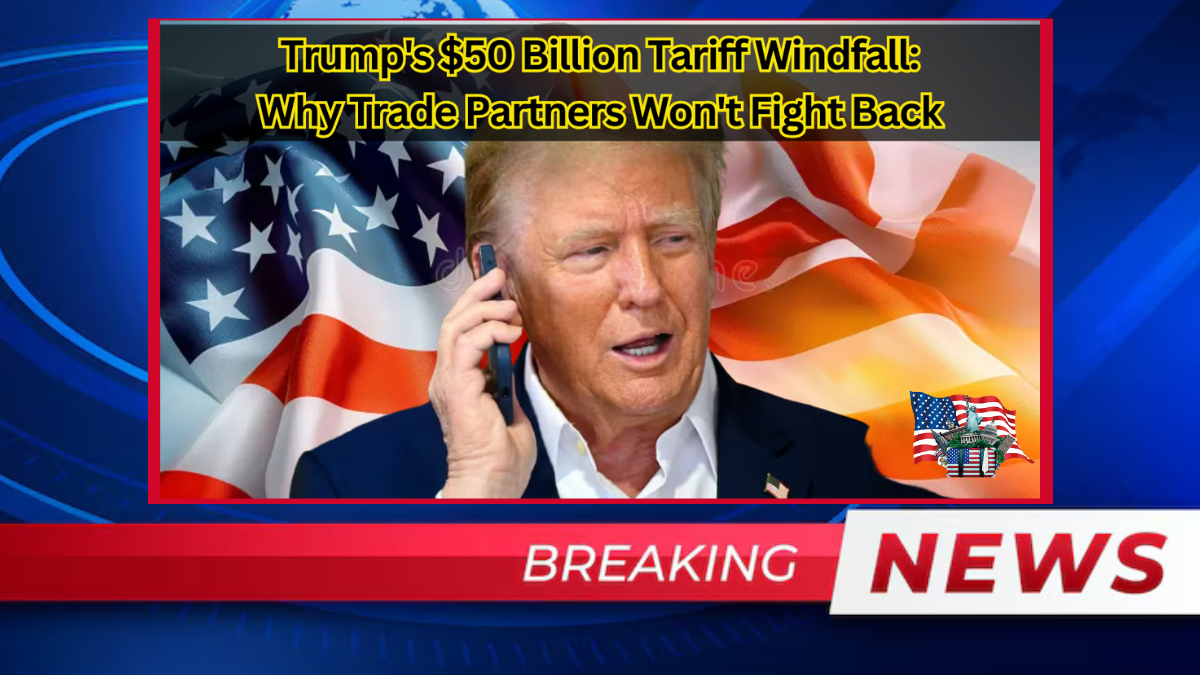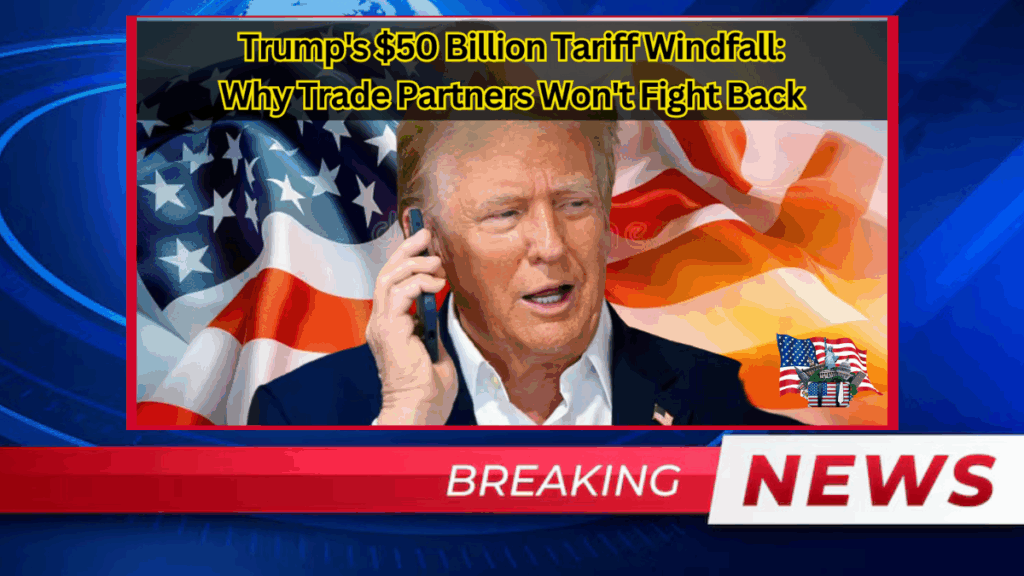President Donald Trump’s aggressive tariff strategy has generated nearly $50 billion in additional revenue for the United States, with most trading partners choosing restraint over retaliation. This surprising development challenges conventional wisdom about trade wars and reveals how global economic dynamics have shifted since Trump’s return to office.
The numbers tell a compelling story. US customs revenue soared to a record $64 billion in the second quarter of 2025, representing a $47 billion increase compared to the same period last year. This windfall comes despite widespread international criticism of Trump’s trade policies, suggesting that threats of retaliation often carry more weight than actual economic consequences.

What makes this situation particularly noteworthy is the limited response from America’s major trading partners. While diplomatic tensions have escalated, only China and Canada have implemented meaningful countermeasures against the sweeping tariffs that include a minimum 10% levy on imports, 50% duties on steel and aluminum, and 25% tariffs on automobiles.
The Mechanics of Trump’s Tariff Strategy
Trump’s current approach builds on lessons learned from his previous presidency while adapting to new global realities. The tariff structure creates multiple pressure points that make retaliation both economically and politically challenging for trading partners.
The 10% baseline tariff affects virtually all imports, creating a broad revenue base while avoiding the concentrated impact that might trigger unified opposition. Higher rates on specific sectors like steel and aluminum target industries where the US has strategic interests, while the 25% automotive tariff addresses one of America’s largest trade deficits.
This tiered approach serves multiple purposes. It generates substantial revenue while giving Trump flexibility to negotiate. Countries facing the threat of even higher tariffs often choose to negotiate rather than escalate, creating a dynamic where the mere possibility of increased duties becomes a diplomatic tool.
The Treasury Department’s June data shows customs duties reaching new records, with collections quadrupling to $27.2 billion on a gross basis. These figures helped produce a surprising $27 billion budget surplus for the month, demonstrating how tariffs have evolved from a trade tool into a significant revenue source.
Why Trading Partners Are Holding Back
The restrained response from major economies reflects several calculated considerations rather than simple acquiescence to American demands. European Union officials have drafted counter-tariffs but continue delaying their implementation, tying them to an August 1 deadline for renewed talks with Washington.
This delay strategy suggests that EU leaders believe negotiation offers better outcomes than escalation. The bloc’s experience with previous trade disputes has shown that tit-for-tat responses often hurt both sides while failing to change fundamental policies.
China’s limited retaliation provides another revealing example. Despite implementing some countermeasures, Beijing’s revenue from duties on US goods increased only 1.9% in May 2025 compared to the previous year. This modest response reflects China’s broader economic challenges and its desire to avoid further destabilizing its already strained relationship with the US.
Canada’s approach has been similarly measured. While Ottawa has voiced strong objections to the tariffs, its actual policy responses have been restrained. The country appears to be betting that diplomatic pressure and multilateral coordination will prove more effective than unilateral retaliation.
Economic Impacts and Market Reactions
The financial success of Trump’s tariff strategy raises important questions about the true costs of trade wars. Traditional economic theory suggests that tariffs hurt both importers and exporters, but the current situation reveals a more complex reality.
American consumers ultimately bear much of the tariff burden through higher prices, but these costs are distributed across the entire economy rather than concentrated in specific sectors. This diffusion makes the impact less visible and politically manageable compared to the highly publicized revenue gains.
Import-dependent industries have adapted by adjusting supply chains, renegotiating contracts, and passing costs to consumers. While these adjustments create economic inefficiencies, they also demonstrate the flexibility of modern trade networks.
The revenue windfall has provided Trump with both financial resources and political capital. Custom duties now represent a meaningful contribution to federal revenues, giving the administration arguments for fiscal responsibility while maintaining popular support for tough trade policies.
Global Supply Chain Adaptations
Trading partners have responded to tariff pressures by restructuring their economic relationships rather than engaging in direct confrontation. Many countries are diversifying their export markets, reducing dependence on the US while developing alternative trade partnerships.
This shift has accelerated existing trends toward regional trade agreements and South-South economic cooperation. Countries that might have previously focused primarily on US markets are now investing in relationships with other major economies.
The automotive sector illustrates these adaptations clearly. Facing 25% tariffs, several major manufacturers have announced plans to relocate production facilities or adjust their supply chains. These moves reduce the immediate impact of tariffs while creating new economic patterns that may persist long after current policies change.
The Role of Negotiation and Diplomacy
Trump’s approach treats tariffs as opening positions in broader negotiations rather than permanent policy fixtures. This strategy creates incentives for trading partners to engage diplomatically rather than respond purely through economic measures.
The August 1 deadline for EU-US talks exemplifies this dynamic. European officials have explicitly linked their retaliation timeline to negotiation opportunities, suggesting that successful talks could prevent escalation entirely.
This negotiation-focused approach has yielded some early successes. Several countries have adjusted their trade practices or made concessions on specific issues to avoid higher tariffs or secure exemptions for key industries.
Looking Ahead: Sustainability and Long-term Consequences
The current situation raises questions about the long-term sustainability of tariff-based trade policies. While Trump has achieved short-term financial and political gains, the broader implications for global trade relationships remain uncertain.
Trading partners’ current restraint may reflect strategic patience rather than permanent acceptance of American tariff policies. Many countries appear to be waiting for potential policy changes or building coalitions for future responses.
The revenue windfall, while politically valuable, creates its own challenges. Future administrations may find it difficult to eliminate tariffs that have become significant revenue sources, potentially institutionalizing policies originally intended as temporary measures.
Redefining Trade War Dynamics
Trump’s tariff success challenges conventional understanding of how trade conflicts unfold. Rather than triggering immediate escalation, his approach has created a new equilibrium where threats often prove more powerful than actual retaliation.
This shift reflects broader changes in global economic power and the increasing complexity of international trade relationships. Countries must now balance multiple priorities, including domestic economic health, international diplomatic relationships, and long-term strategic positioning.
The results suggest that trade policy effectiveness depends as much on political will and strategic timing as on economic fundamentals. Trump’s ability to generate substantial revenue while avoiding major retaliation demonstrates how bold policy approaches can reshape established patterns of international economic interaction.
The implications extend beyond current trade disputes. Future leaders may draw lessons about the effectiveness of unilateral economic pressure, while trading partners may develop new strategies for responding to aggressive trade policies without triggering damaging escalation cycles.
FAQs: Frequently Asked Questions
1. What were the $50 billion in tariffs imposed by Trump?
A. The tariffs were a set of duty charges placed mainly on imported goods from countries like China, targeting industries such as technology, steel, and agriculture. The goal was to address trade imbalances and protect domestic industries.
2. Why did most trading partners avoid retaliating to these tariffs?
A. Many trading partners chose to avoid full-scale retaliation to prevent escalating trade conflicts that could harm their economies further. Instead, they adopted alternative strategies like seeking exemptions or engaging in negotiations.
3. How did these tariffs generate $50 billion in revenue?
A. The tariffs collected duties on imported goods that continued to enter the U.S. despite higher costs. Importers and consumers ultimately absorbed these prices, contributing to significant tariff revenue.
4. What lessons can future leaders learn from this strategy?
A. Future leaders may study the impact of such tariffs on trade relationships and revenue generation. The approach demonstrates the potential effectiveness of economic pressure but also highlights the risks of prolonged trade tensions.
5. Did the tariffs have any negative effects?
A. Yes, the tariffs led to higher costs for businesses and consumers, disrupted supply chains, and strained relationships with trading partners. These factors raised questions about the long-term benefits of the tariff strategy.
For More Information Click Here

